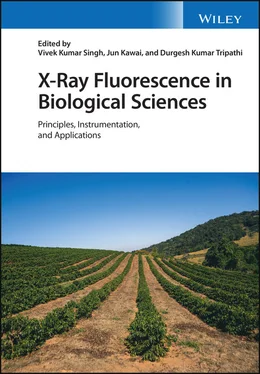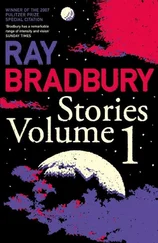X-Ray Fluorescence in Biological Sciences
Здесь есть возможность читать онлайн «X-Ray Fluorescence in Biological Sciences» — ознакомительный отрывок электронной книги совершенно бесплатно, а после прочтения отрывка купить полную версию. В некоторых случаях можно слушать аудио, скачать через торрент в формате fb2 и присутствует краткое содержание. Жанр: unrecognised, на английском языке. Описание произведения, (предисловие) а так же отзывы посетителей доступны на портале библиотеки ЛибКат.
- Название:X-Ray Fluorescence in Biological Sciences
- Автор:
- Жанр:
- Год:неизвестен
- ISBN:нет данных
- Рейтинг книги:5 / 5. Голосов: 1
-
Избранное:Добавить в избранное
- Отзывы:
-
Ваша оценка:
- 100
- 1
- 2
- 3
- 4
- 5
X-Ray Fluorescence in Biological Sciences: краткое содержание, описание и аннотация
Предлагаем к чтению аннотацию, описание, краткое содержание или предисловие (зависит от того, что написал сам автор книги «X-Ray Fluorescence in Biological Sciences»). Если вы не нашли необходимую информацию о книге — напишите в комментариях, мы постараемся отыскать её.
Discover a comprehensive exploration of X-ray fluorescence in chemical biology and the clinical and plant sciences X-Ray Fluorescence in Biological Sciences: Principles, Instrumentation, and Applications
X-Ray Fluorescence in Biological Sciences: Principles, Instrumentation, and Applications
X-Ray Fluorescence in Biological Sciences — читать онлайн ознакомительный отрывок
Ниже представлен текст книги, разбитый по страницам. Система сохранения места последней прочитанной страницы, позволяет с удобством читать онлайн бесплатно книгу «X-Ray Fluorescence in Biological Sciences», без необходимости каждый раз заново искать на чём Вы остановились. Поставьте закладку, и сможете в любой момент перейти на страницу, на которой закончили чтение.
Интервал:
Закладка:
Galina V. PashkovaInstitute of the Earth’s Crust SB RAS Irkutsk Russia
Paula PongracDepartment of Biology Biotechnical Faculty University of Ljubljana Ljubljana Slovenia and Department for Low and Medium Energy Physics Jožef Stefan Institute Ljubljana Slovenia
Sanjiv PuriDepartment of Basic and Applied Sciences Punjabi University Patiala India
Ignasi QueraltInstitute of Environmental Assessment and Water Research IDAEA‐CSIC Barcelona Spain
Kanishka RawatApplied Nuclear Physics Division Saha Institute of Nuclear Physics Kolkata West Bengal India
Anatoly G. RevenkoInstitute of the Earth’s Crust SB RAS Irkutsk Russian Federation
Inderjeet S. SandhuChitkara University Institute of Engineering and Technology Chitkara University Punjab India
Valentin SemenovInstitute of Chemistry St. Petersburg State University Saint Petersburg Russia
Neha SharmaDepartment of Physics University of Lucknow Lucknow Uttar Pradesh India and School of Physics Shri Mata Vaishno Devi University Katra Jammu and Kashmir India
Darya S. SharykinaInstitute of the Earth’s Crust SB RAS Irkutsk Russian Federation
Yating ShenNational Research Center of Geoanalysis Beijing China
Rakesh K. SindhuChitkara College of Pharmacy Chitkara University Rajpura Punjab India and Swami Devi Dyal Institute of Pharmacy Panchkula Haryana India
Harinderjit SinghAdesh Institute of Pharmacy & Biomedical Sciences Adesh University Bathinda Punjab India
Harpreet Singh KainthDepartment of Basic and Applied Sciences Punjabi University Patiala India
Tejbir SinghDepartment of CIL/SAIF Panjab University Chandigarh India
Gurjeet SinghDepartment of Physics Punjabi University Patiala India
M. SudarshanUGC‐DAE Consortium for Scientific Research Kolkata India
M.K. TiwariSynchrotrons Utilization Section Raja Ramanna Centre for Advanced Technology (RRCAT) Indore India
V.A. TrunovaNikolaev Institute of Inorganic Chemistry SB RAS Novosibirsk Russia
Onkar N. VermaDepartment of Physics University of Lucknow Lucknow Uttar Pradesh India
Inderjeet VermaM.M. College of Pharmacy MM(DU) Mullana‐Ambala India
Katarina Vogel‐MikušDepartment of Low and Medium Energy Physics Jožef Stefan Institute Ljubljana Slovenia and Department of Biology Biotechnical Faculty University of Ljubljana Ljubljana Slovenia
Neera YadavCollege of Pharmacy Gachon University of Medicine and Science Incheon City South Korea
Shantanu K. YadavChikara College of Pharmacy Chikara University Punjab India
Hiroshi YoshiiNational Institute of Radiological Science National Institutes for Quantum Science and Technology Chiba Japan
Jing YuanEast China Center for Geoscience Innovation Nanjing Center of Geological Survey China Geological Survey Nanjing China
Rafail A. YusupovDepartment of Analytical Chemistry Certification and Quality Management Kazan National Research Technological University Kazan Russia
Shuai ZhuNational Research Center of Geoanalysis Beijing China
Purev ZuzaanNuclear Research Center National University of Mongolia Ulaanbaatar Mongolia
Preface
X‐ray fluorescence (XRF) spectroscopy is a well‐established analytical technique being used extensively for mining, metallurgy, petroleum, and geological studies, though not widely used for biological applications. During the past decade, XRF spectrometry has gone through major changes in the field of biological sciences. This book is a guide which provides an up‐to‐date review of XRF spectrometry for biological, medical, food, environmental, and plant science researchers. It covers the basic principles and latest developments in instrumentation and applications of X‐ray fluorescence in biological sciences. This also provides a thoroughly updated and expanded overview to industry professionals in X‐ray analysis over the last decades. The main feature of this book is that it provides information about XRF techniques and procedures for qualitative and quantitative analysis of biological specimens worth modern applications and industrial trends.
The chapters are contributed by independent groups in the world. Four chapters are contributed by the members of editorial advisory board of the journal “X‐Ray Spectrometry” from Wiley. The chapters are divided into six parts. Part 1 is a general introduction of XRF. Parts 2 and 3 are most advanced methods of SR‐XRF and TXRF, which are micro‐XRF, high sensitivity (low detection limit) XRF. Part 4, a beginner’s guide, is one of the characteristics of the present book. Parts 5 and 6 are the main parts of the present book.
Part I(General Introduction) consists of seven (07) chapters. Chapter 1describes about the XRF and comparison with other analytical methods such as AAS, ICP‐AES, LA‐ICP‐MS, IC, LIBS, SEM‐EDS, and XRD. Chapter 2highlights the significant role of different XRF configurations for both multi‐elemental bulk analysis and element distribution within vegetal tissues. In Chapter 3, the application of XRF analysis is described for the chemical compositions of tea and coffee samples. Chapter 4deals with total reflection X‐ray fluorescence (TXRF) spectrometry and its suitability for biological samples. In this chapter, the fundamentals, basic principles, and theoretical aspects of TXRF have been discussed along with its advantages and limitations. Chapter 5describes the use and application of μ‐XRF and XANES to understand the interaction process and mechanism between microorganisms and heavy metal. Chapter 6covers the details of EDXRF techniques for the application to clinical samples such as blood and hair. In Chapter 7, all considerations related with the sample preparation process are summarized which is very crucial for XRF analysis.
Part II(Synchrotron Radiation XRF) consists of five (05) chapters which show how Synchrotron Radiation XRF (SRXRF) can be used to provide analytical information in biological sciences for elemental composition. Chapter 8covers numerous aspects of SRXRF and its applications. This chapter highlights the usefulness of XRF technique for the elemental characterization of different sample matrixes in non‐destructive manners. Chapter 9deals with the application of SR‐based micro‐XRF spectroscopy for plants. Chapter 10covers the application of μ‐XRF to study toxic elements in plants. Chapter 11highlights the application of micro‐XRF for the analysis of benthonic fauna (earthworm and nematodes) in soils and sediments. Chapter 12discusses in detail the use of SRXRF for the analysis of microelements in biopsy tissues.
Part III(Total Reflection XRF) consists of four (04) chapters which describe in detail the principles and basic fundamentals of total reflection XRF (TXRF) along with their biological applications. Chapter 13covers the applications of TXRF for the trace element determinations in marine organisms, blood samples, saliva and oral fluids, hairs, nails, kidney stones, urine samples, and forensic samples. Chapter 14demonstrates the applications of combined X‐ray reflectivity ( XRR ) and grazing incidence X‐ray fluorescence (GIXRF) technique for the characterization of thin films and nano‐structured materials. Chapter 15deals with the analysis of alcoholic and non‐alcoholic beverages by TXRF. Chapter 16describes the details of using TXRF and XRT techniques for trace elemental analysis of blood and serum samples.
Читать дальшеИнтервал:
Закладка:
Похожие книги на «X-Ray Fluorescence in Biological Sciences»
Представляем Вашему вниманию похожие книги на «X-Ray Fluorescence in Biological Sciences» списком для выбора. Мы отобрали схожую по названию и смыслу литературу в надежде предоставить читателям больше вариантов отыскать новые, интересные, ещё непрочитанные произведения.
Обсуждение, отзывы о книге «X-Ray Fluorescence in Biological Sciences» и просто собственные мнения читателей. Оставьте ваши комментарии, напишите, что Вы думаете о произведении, его смысле или главных героях. Укажите что конкретно понравилось, а что нет, и почему Вы так считаете.











